« Prev Next »

Submarine fans are accumulations of sediment deposited at the termini of land-to-deep-sea sediment-routing systems (Menard 1955) (Figure 1). At a given moment in time, sediment-routing systems comprise sediment source areas dominated by denudation, a zone of sediment transfer, and a terminal region of deposition, such as a submarine fan (Allen 1997). The sediment-transfer zone between terrestrial source area and deep-sea depositional sink can include submarine canyon-channel systems, which generally pass from erosional V-shaped canyons indenting the continental shelf and uppermost slope, to U-shaped channels with overbank deposits across the lower slope and rise (Figure 2). Submarine fans are deposited at their termini and generally exhibit radial-, cone-, or fan-like morphologies in map view across the seafloor (Menard 1955) (Figure 1). However, receiving-basin geometry and substrate mobility can modify fan morphology (e.g., Nelson & Kulm 1973, Pickering 1982, Stow et al. 1985, Mutti & Normark 1987, Shanmugam & Moiola 1988, Prather et al. 1998, Booth et al. 2000, Piper & Normark 2001, Covault & Romans 2009) (Figure 1). Moreover, during the course of basin evolution, submarine fans can be uplifted by tectonic forces and subsequently eroded and redeposited.
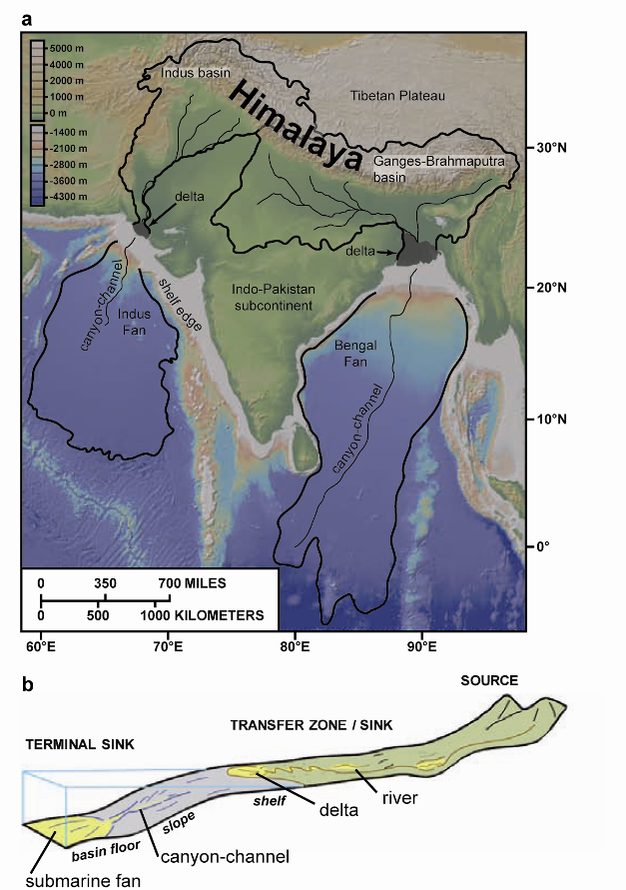
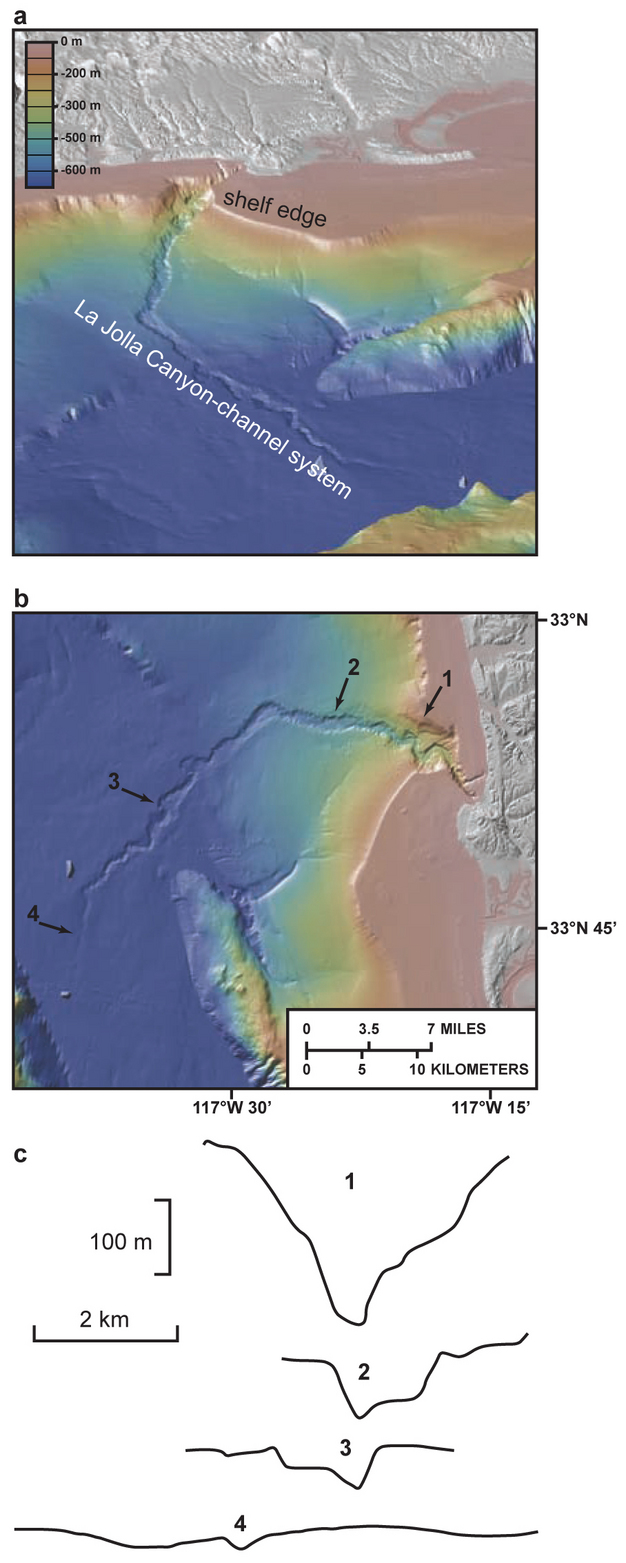
Submarine fans constitute the largest accumulations of genetically related detritus on Earth (e.g., the Bengal and Indus fans, which are linked to South Asian sediment source areas; Figure 1). Fan sediment includes the deposits of sediment gravity flows and other submarine mass movements. Perhaps the most widely recognized sediment-gravity-flow deposit is called a turbidite – thus, fans are also referred to as turbidite systems (Bouma et al. 1985). Fans and related turbidite systems are present on the seafloor, and their deposits have been recognized in the subsurface and in outcrops.
Because submarine fans and related turbidite systems are located at the termini of continent-draining, sediment-routing systems, their deposits contain a wealth of proxy information pertaining to past climate and perturbations to their up-depositional-dip sedimentary systems. A convincing demonstration of interactions between the Earth's surface and circulation patterns of the atmosphere and oceans can be provided by deposits in submarine fans, which can provide a relatively complete and readily dated record of tectonic deformation, climate change, and erosion, compared to onshore records (Clift & Gaedicke 2002, Covault et al. 2010). Sediment flux over millions of years from South Asian hinterlands to the Indus Fan was compared to tectonic and climatic conditions in order to approximate their relative influences on sediment routing (Clift & Gaedicke 2002). However, sediment can be temporarily stored (i.e., generally less than 1-3 million years; Clift & Gaedicke 2002) in rivers, flood plains, estuaries, and/or subsiding deltas, en route to submarine fans in extensive routing systems that drain large continental areas. This sediment storage can introduce significant lag time between onshore forcings – e.g., tectonic and/or climatic fluctuations, and offshore deposition (Jerolmack & Paola 2010). For example, the South Asian-Indus sediment-routing system exhibits an order of magnitude reduction in sediment flux from terrestrial sediment source areas to the Indus Fan prior to the development of major dams during the twentieth century, with sediment sequestered on the vast coastal plain and continental shelf (Milliman et al. 1994).
The burial of organic carbon in submarine-fan sediment influences the global inventory of carbon on Earth's surface, and is potentially a key control on carbon dioxide concentrations over millions of years. Organic carbon burial in submarine sediment represents the second largest global sink of atmospheric carbon dioxide after the combined process of silicate weathering and subsequent carbonate precipitation (Galy et al. 2008). Erosion of the Himalayas of South Asia and sediment transfer offshore to the Bengal submarine fan are responsible for 10-20% of the global burial of organic carbon, derived from terrestrial plant detritus, associated soil organic matter, and autotrophic carbon production by aquatic plants, implying a global impact on the organic carbon cycle (Galy et al. 2008). High-standing islands of the southwest Pacific Ocean, including New Zealand, Taiwan, Indonesia, Malaysia, Papua New Guinea, and the Philippines, make up only ~3% of Earth's landmass, but the short lengths and steep gradients of the streams and the high variability of rainfall on these islands enable water and sediment to be quickly routed from hinterlands to the ocean (Milliman & Syvitski 1992). Consequently, these islands have been estimated to contribute 17-35% of the particulate organic carbon to the world's oceans and submarine depositional systems (Lyons et al. 2002).
Submarine fans can also be prolific hosts for oil and gas resources (Pettingill & Weimer 2002). Approximately 58 billion barrels of oil equivalent have been discovered in water depths >500 m from 18 basins on six continents as of 2002 (Pettingill & Weimer 2002). However, only ~25% of the discoveries were developed or under development, and <5% were produced as of 2002 (Pettingill & Weimer 2002). Most resources have been found in the Gulf of Mexico, offshore Brazil, and offshore West Africa (Pettingill & Weimer 2002). Exploration and development of the world's resources hosted in submarine fans and related turbidite systems are at relatively immature stages as a result of infrastructure and economic limitations, but destined to become a major future focus (Pettingill & Weimer 2002). Moreover, advances in predictive models of continental-margin stratigraphic architecture are revolutionizing oil and gas exploration (e.g., Weimer & Link 1991, Weimer et al. 1994, Prather et al. 1998, Stow & Mayall 2000, Weimer et al. 2000, Mutti et al. 2003, Posamentier & Kolla 2003, Roberts et al. 2003, Wynn & Cronin 2007, Amy et al. 2009, Hubbard et al. 2011).
A Brief History of Exploration of Submarine Fans and Canyon-Channel Systems
Submarine canyons are erosional V-shaped features that gash the world's continental margins (Normark & Carlson 2003) (Figure 3). They became increasingly recognized during the twentieth century as acoustically based marine geophysical observations were made (Daly 1936) (Figure 4). Sound waves from a powerful shipborne source bounce off boundaries between strata, or at the water-seafloor interface, and the wave travel times are recorded by a receiver at the ship and plotted (Moore 1969) (Figure 4). The resulting plots document travel times from the ship to these boundaries defined by differences in acoustic impedance (i.e., the product of the characteristic sound-wave velocity of the medium through which the wave travels and the density of the medium; Sheriff 1977). These plots, called seismic-reflection profiles, resemble geologic cross sections, with the distinctive difference that the vertical axis of seismic-reflection profiles is time, not depth, and subsurface media have different characteristic velocities (e.g., from <2 km/s for sediment to >8 km/s for ultramafic rock).
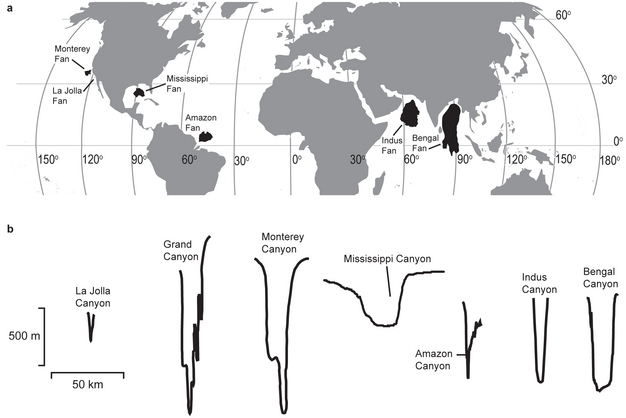
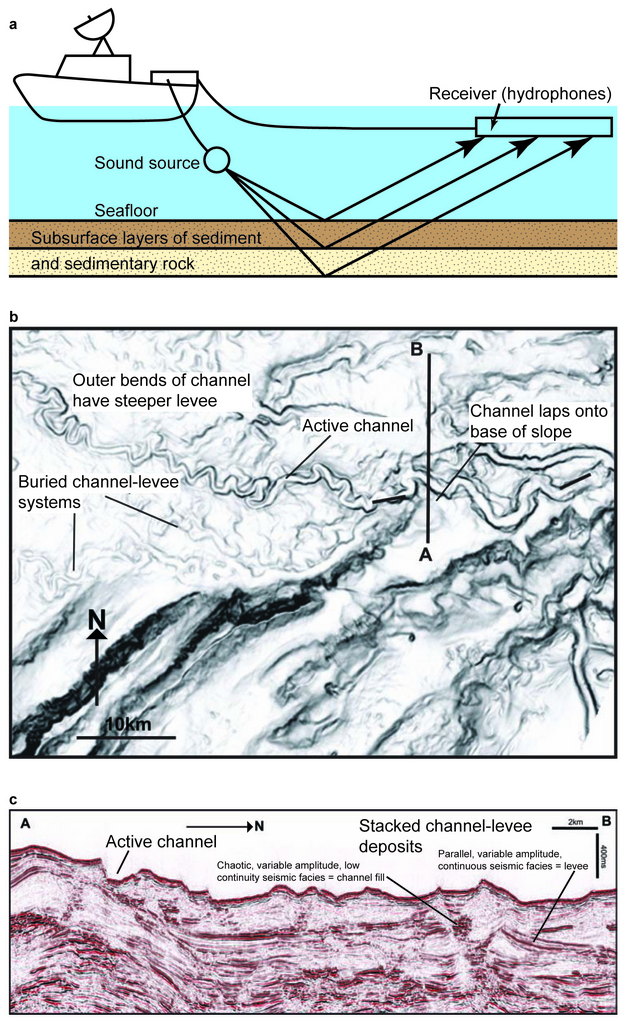
In some cases, canyons extend for hundreds of kilometers across the seafloor and transition to U-shaped, generally higher-aspect-ratio channels with overbank deposits across the lower continental slope and rise (Shepard & Emery 1941) (e.g., Figure 2). Expansive depositional systems were imaged at the mouths of some of these submarine canyon-channel systems, the early examples of which generally formed radial-, cone-, or fan-like depositional morphologies in map view across the seafloor (Shepard & Emergy 1941, Dill et al. 1954, Menard 1955, Heezen et al. 1959) (Figures 1-3). Menard (1955) coined the term "submarine fans" for these depositional systems, analogous to the morphology of alluvial fans that are familiar to terrestrial geologists. Subsequent observations of submarine fans illuminated the predominance of irregular map-view morphology owed to differences in deep-sea basin morphology, sediment supply from terrestrial source areas, and/or characteristic sediment caliber and composition (Nelson & Kulm 1973, Bouma et al. 1985, Mutti & Normark 1987) (Figure 3). Thus, geologists suggested the more general term "turbidite system" for deep-sea depositional systems, with the term "submarine fan" reserved for systems with a general fan shape and well-developed channel and levee elements analogous to a terrestrial fluvial system (Nelson et al. 1978, Bouma et al. 1985).
Bill Normark pioneered work on "modern" submarine fans and canyon-channel systems from observations of the seafloor offshore southern California, USA, and Baja California, Mexico (Normark 1970). "Modern" refers to deposits whose geometry and surface morphology reflect original depositional conditions, usually on the seafloor or in the shallow subsurface (Mutti & Normark 1991). "Ancient" depositional systems commonly include outcropping or subsurface turbidite systems that have been deformed by tectonic processes (Mutti & Normark 1991). Normark's (1970) submarine-fan model focused on canyon-channel systems and lobes, which are sediment accumulations at the terminal mouths of channels (Figure 5a). These accumulations commonly exhibit shallow and ephemeral distributary channels, with morphologies reminiscent of deltaic distributary channels, but likely controlled by fundamentally different sedimentary processes (Rowland et al. 2010). The deep-sea distributary channel network can be filled with coarse-grained sediment that grades peripherally into areas of smoother topography and finer-grained sediment.
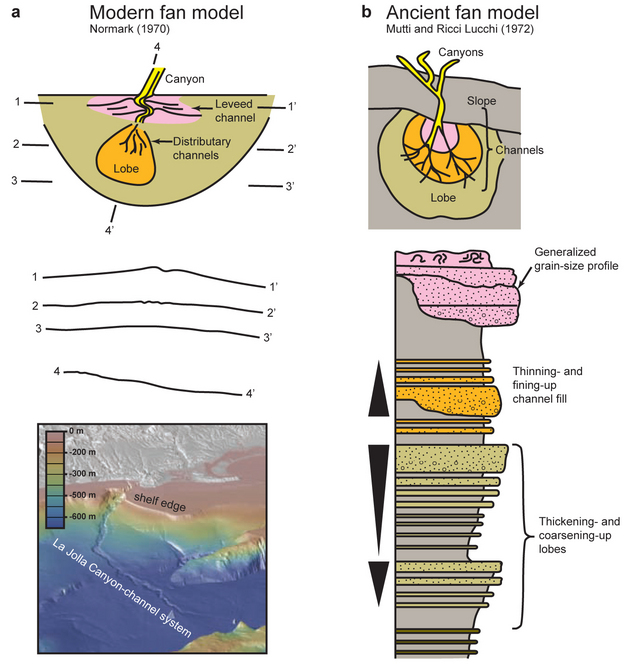
Nearly contemporaneous with the advent of Bill Normark's submarine-fan model, Mutti & Ricci Lucchi (1972) established a comparable model based on the geometry and internal organization of turbidite sandstone bodies outcropping in Apenninic and Pyrenean mountain ranges of Europe (Figure 5b). They placed particular emphasis on the analysis of vertical successions of sedimentary rock. Channel-fill deposits were recognized by upward-fining grain size and upward-thinning turbidite beds (Mutti & Ricci Lucchi 1972). Progradation of unchannelized, sheet-like sandstone lobes was interpreted from upward-coarsening and -thickening grain size and bed successions, respectively. The integration of observations from both modern and ancient submarine fans and related turbidite systems (e.g., Walker 1978) has led to the recognition of common architectural elements present at a variety of scales (e.g., Mutti & Normark 1987, 1991, Normark et al. 1993, Posamentier & Kolla 2003). These elements include large-scale erosional features and canyons, channels, levees and overbank wedges, and lobe deposits (Figure 5). Mutti et al. (2009) provide a thorough historical review of conceptual models of submarine-fan and related turbidite-system development.
Depositional Processes of Submarine Fans
Submarine mass movements.
Submarine fans and related turbidite systems comprise deposits of mass movements, including slides, slumps, turbidity currents, and debris flows (Middleton & Hampton 1973) (Figure 6). Slides typically consist of large, intact blocks moving on a well-defined slippage plane, whereas slumps may break up into smaller blocks and generally exhibit some internal deformation of original bedding (Middleton & Hampton 1973). Slides and slumps are distinguished from debris flows and turbidity currents, which are types of sediment gravity flows, according to the degree of internal deformation: slides and slumps are characterized by less internal deformation, sediment gravity flows are characterized by more (Middleton & Hampton 1973) (Figure 6). A sediment gravity flow is a general term for a mixture of sediment and water in which the sediment component pulls interstitial water down slope under the action of gravity (Bagnold 1962, Middleton & Hampton 1973). Down-slope movement takes place because of the difference in unit weight between the gravity flow and ambient water (Middleton 1993). Perhaps the most widely recognized deposit in submarine fans and related turbidite systems is a turbidite, the deposit of a turbidity current (Bouma et al. 1985). I will focus the following discussion on general sediment-gravity-flow support mechanisms, and depositional processes and products.
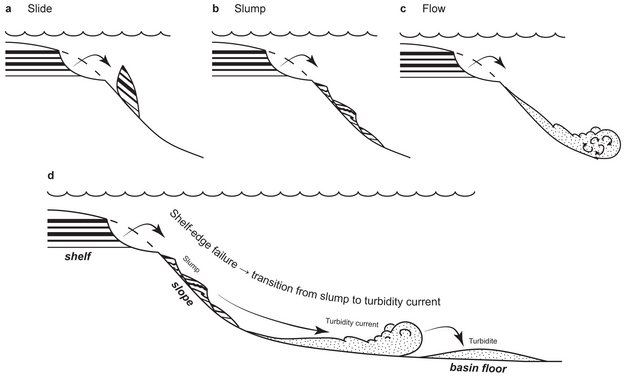
Sediment gravity flows and their deposits.
A catastrophic, large-scale sediment gravity flow has still not been directly observed in the ocean. Such flows are difficult to monitor because they are rare over historic, observational time scales, and initiation mechanisms are poorly understood and unpredictable (Piper & Normark 2009). Rather, the occurrence of sediment gravity flows has been inferred from destruction of underwater infrastructure, such as submarine cable breaks (e.g., Heezen & Ewing 1952, Heezen et al. 1964). In lieu of direct observations of these flows, their behavior is interpreted from depositional products (e.g., Migliorini 1943, Kuenen & Migliorini 1950, Bouma 1962, Middleton & Hampton 1973, Lowe 1982, Ricci Lucchi 2003), and from models based on physical theory (e.g., Parker et al. 1986) and experimentation (e.g., Garcia & Parker 1989).
Middleton & Hampton (1973) differentiated sediment gravity flows on the basis of dominant sediment-support mechanism (Figure 7). Debris flows are at one end of the spectrum, and include large grains and gravel supported by a cohesive matrix of interstitial fluid and fine-grained sediment with finite yield strength (Middleton & Hampton 1973). Increasing fluid content in these flows tends to decrease their yield strength. Moreover, with increasing fluid content and progressively less frequent particle interactions, a debris flow transitions to a grain flow and fluidized sediment flow. Sediment is supported by dispersive pressure arising from grain-to-grain interactions in a grain flow and upward escaping pore fluid in a fluidized sediment flow. Turbidity currents are at the other end of the spectrum of gravity flows, in which sediment is predominantly supported by the upward component of fluid turbulence (Middleton & Hampton 1973). Submarine mass movements commonly undergo significant transformations en route to deposition on submarine fans (Fisher 1983). For example, a shelf-edge sediment failure might initially behave as a slide and/or slump, followed by a debris flow and turbidity current as fluid content increases down slope (Figure 6). However, slumps or debris flows hypothetically might change to turbidity currents with no change in water content when velocity is great enough to produce internal turbulence (Kuenen 1952, Morgenstern 1967, Fisher 1983). In reality, a flow can transform more than once and in different, unpredictable ways (Fisher 1983). Seafloor topography can influence flow behavior and transformations with associated processes of erosion and deposition (Kneller 1995, Kneller & McCaffrey 1999).

Lowe (1982) provided a synthesis of basic depositional processes of turbidity currents (Figure 8) and debris flows. Sediment within a turbidity current that is moved as bed load-i.e., grains that move by sliding, rolling, and/or saltation in constant or intermittent contact with the bed, is deposited by traction sedimentation. Sediment that is entrained higher in the flow and is transported downstream by fluid turbulence settles out of suspension. Debris flows are generally deposited en masse by cohesive freezing as the applied shear stress drops below the yield strength of the moving material. Perhaps the most diagnostic trait in these deposits is the degree of sorting. Sorting refers to the distribution of sediment grain sizes in a deposit. Turbidites generally are better sorted, with similar grain sizes, than deposits of debris flows, with mixed grain sizes.
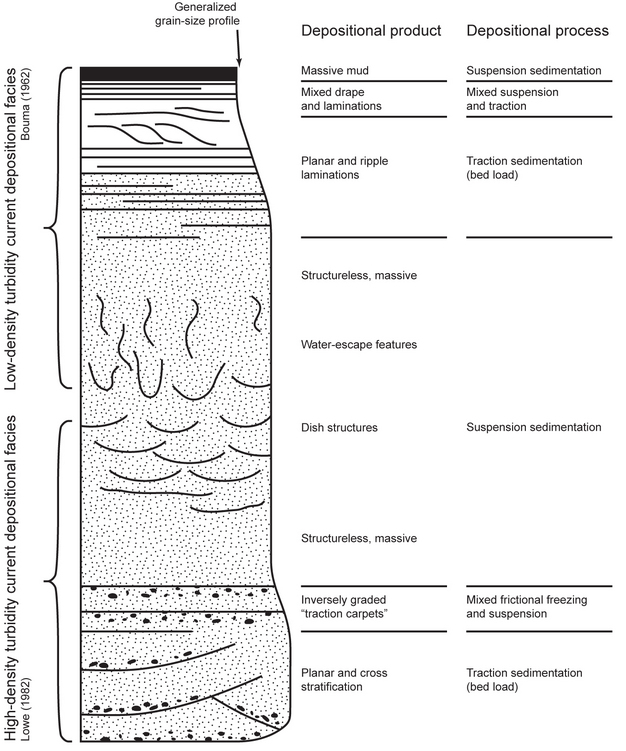
Lowe (1982) described deposition of relatively fine-grained, low-density turbidity currents to include an initial, brief period of suspension sedimentation, followed by traction sedimentation, mixed traction and suspension sedimentation, and concluding with a terminal period of predominantly mud settling out of suspension. These depositional processes were originally interpreted from sedimentary structures of turbidites of western Alpine outcrops by Bouma (1962), following pioneering work on graded bedding of Migliorini (1943) and Kuenen & Migliorini (1950) (Figure 8). The grain size of deposits of low-density turbidity currents generally decreases upward-i.e., normal grading (Kuenen & Migliorini 1950). The idealized sequence of sedimentary structures includes a basal division of structureless, massive sand overlain by planar and ripple sand laminations, a mixed laminated and draping very fine-grained sand and silt division, and capped by a massive mud division (Bouma 1962) (Figure 8).
Deposits of higher-density turbidity currents of mixed fine- and coarse-grained sediment caliber were interpreted to reflect a series of sedimentation waves as currents decelerate and grain populations can no longer be transported - generally passing from a stage of traction sedimentation, to mixed frictional freezing and suspension sedimentation, to predominantly suspension sedimentation, to a final stage of low-density turbidity current deposition of the remaining flow (Lowe 1982) (Figure 8). The idealized sequence of sedimentary structures includes a basal division of planar- and cross-stratified sand and pebbly sand overlain by an inversely graded "traction carpet" of coarse-grained sand, and capped by massive or dish-structured sand and structures characteristic of deposits of low-density turbidite currents (Lowe 1982) (Figure 8). Haughton et al. (2009) provide a comprehensive review of sediment-gravity-flow types and their deposits intermediate between debris-flow deposits and turbidites.
Models of Submarine-Fan Development
Sequence stratigraphy places submarine fans and related turbidite systems in the temporal and spatial context of sedimentary-basin development (e.g., Mitchum 1985, Posamentier et al. 1988, 1991). Sequence stratigraphy is a method of describing and interpreting strata on the basis of changes in the internal and morphologic character of stratigraphic packages within a framework of chronostratigraphically significant surfaces (Vail et al. 1977, Catuneanu et al. 2010) (Figure 9). One of its fundamental concepts is the importance of the balance between sediment supply and space for sediment accumulation, called "accommodation" (Jervey 1988). When sediment supply is sufficient to overwhelm nearshore accommodation on the continental shelf, deposition can be focused on submarine fans in the deep sea. Accommodation creation and destruction have been tied to sea-level fluctuations, especially those caused by glacial eustasy. Hypothetically, when sea level falls, accommodation on the shelf is relocated basinward to the deep sea. Fluvial systems are able to cross the subaerially-exposed shelf and deliver their sedimentary loads to the heads of submarine canyon-channel systems, which funnel the sediment to deep-sea fans (Figure 9).

Posamentier et al. (1991) noted that sediment delivery to submarine fans and related turbidite systems can occur during any stand of sea level if canyon heads have been incised across continental shelves to the modern beach (Covault & Graham 2010). Such is the case for nearly half of the prominent submarine canyons in the tectonically active California Continental Borderland, the region offshore southern California characterized by a relatively narrow shelf and complex basin-and-ridge bathymetry (Shepard & Emery 1941, Normark et al. 2009) (Figure 9). For example, the La Jolla Canyon is solely fed sediment from longshore drift through the Oceanside littoral cell and lacks a prominent fluvial contributor (Covault et al. 2007). Similarly, when sediment supply is sufficient to push deltas to the edges of shelves, deep-water deposition can ensue independent of sea-level fluctuations (Burgess & Hovius 1998, Carvajal et al. 2009).
Source-to-Sink Integration
In light of the complexity of developmental models of submarine fans and related turbidite systems, Earth scientists have increasingly employed more comprehensive analyses of entire land-to-deep-sea sediment-routing systems. The appeal of source-to-sink studies is the promise of improved geomorphic and stratigraphic predictive relationships for petroleum-reservoir and continental-margin evolutionary models, especially when integrated with traditional methodologies (cf., Sømme et al. 2009). The potential of source-to-sink concepts is that local aspects of systems can provide predictions of the character of submarine fans and other tracts of depositional sequences along the routing system. For example, local aspects, such as source-area composition, characteristics of the fluvial and submarine canyon-channel sediment-transfer zone, and tectono-climatic fluctuations, can provide predictions of the supply, mineralogy, and caliber of sediment composing a submarine fan, as well as predictions of morphologic character (Sømme et al. 2009).
Recent advances in source-to-sink sedimentary research predominantly have been driven by studies of the modern Earth surface and latest Quaternary strata (e.g., Sømme et al. 2009). The elegance of these studies lies in the full plan-view display of those systems: segments are geographically arrayed, many tools can be used to investigate the elements at high spatial and temporal resolution, and ultimately, the linkage between process and product may be understood (Graham et al. 2011). Work has been focused on the timing and processes of sediment routing and deposition, the propagation of signals of stratigraphic forcings, the utility of the stratigraphic record as a proxy for paleo-environmental conditions, and the relative contributions of external, allogenic and intrinsic, autogenic processes to the stratigraphic record. An important, and yet unanswered, research question is how submarine fan morphologies might vary as a result of different sediment-flux regimes.
Summary
Submarine fans are the largest accumulations of genetically related detritus in the world. They receive terrigenous sediment from hinterland-to-deep sea sediment-routing systems, which include submarine canyon-channel transfer zones that gash Earth's continental margins. Deposits of fans and related turbidite systems can record signals of tectonic and climatic fluctuations, and serve as globally significant reservoirs of particulate organic carbon and petroleum resources. Seismic-reflection- and outcrop-based observations of turbidite systems have led to the recognition of common architectural elements, including canyons, channels, levees and overbank wedges, and lobe deposits. Perhaps the most widely recognized deposit in fans and related turbidite systems is a turbidite, the deposit of a type of sediment gravity flow called a turbidity current. Sediment-gravity-flow and turbidity-current sedimentary processes are largely interpreted from depositional products, physical models, and experimentation. Sequence stratigraphic models of fan and related turbidite-system development highlight the balance between sediment supply and accommodation. When sediment supply is sufficient to overwhelm nearshore accommodation on the continental shelf, deposition can be focused on submarine fans in the deep sea.
Acknowledgements.
I thank colleagues at Chevron's Energy Technology Company and the Stanford Project on Deep-water Depositional Systems for discussions. This manuscript benefited from reviews by William Craddock, Stephen Hubbard, Andrea Fildani, James Coleman, and Figen Mekik.
References and Recommended Reading
Allen, P. A. Earth Surface Processes. Hoboken, NJ: John Willey & Sons, 1997.
Amy, L. et al. Sediment gravity flows - Recent insights into their dynamic and stratified/composite nature. Marine and Petroleum Geology 26, 1897-2044 (2009).
Apps, G. M. et al. "Structural controls on Tertiary deep water deposition in the northern Gulf of Mexico," in Submarine Fans and Turbidite Systems, eds. P. Weimer et al. (Tulsa, OK: Gulf Coast Section-Society of Economic Paleontologists and Mineralogists, 1994) 1-7.
Bagnold, R. A. Auto-suspension of transported sediment: Turbidity currents. Proceedings of the Royal Society A: Mathematical, Physical & Engineering Sciences 265, 315-319 (1962).
Booth, J. R. et al. "Sequence stratigraphic framework, depositional models, and stacking patterns of ponded and slope fan systems in the Suger Basin: Central Gulf of Mexico slope," in Deep-Water Reservoirs of the World, eds. P. Weimer et al. (Tulsa, OK: Gulf Coast Section-Society of Economic Paleontologists and Mineralogists, 2000) 82-103.
Bouma, A. H. Sedimentology of Some Flysch Deposits: A Graphical Approach to Facies Interpretation. New York, NY: Elsevier, 1962.
Bouma, A. H. et al. Submarine Fans and Related Turbidite Systems. New York, NY: Springer-Verlag, 1985.
Burgess, P. M. & Hovius, N. Rates of delta progradation during highstands: Consequences for timing of deposition in deep-marine systems. Geological Society of London 15, 217-222 (1998).
Carvajal, C. et al. Sediment supply: The main driver of shelf-margin growth. Earth-Science Reviews 96, 221-248 (2009).
Catuneanu, O. Sequence stratigraphy of clastic systems: Concepts, merits, and pitfalls. Journal of African Earth Sciences 35, 1-43 (2002).
Catuneanu, O. et al. Towards the standardization of sequence stratigraphy. Earth-Science Reviews 92, 1-33 (2009).
Clift, P. & Gaedicke, C., Accelerated mass flux to the Arabian Sea during the middle to late Miocene. Geology 30, 207-210 (2002).
Covault, J. A. et al. Highstand fans in the California borderland: The overlooked deepwater depositional systems. Geology 35, 783-786 (2007).
Covault, J. A. & Romans, B. W. Growth patterns of deep-sea fans revisited: Turbidite-system morphology in confined basins, examples from the California Borderland. Marine Geology 265, 51-66 (2009).
Covault, J. A. et al. Rapid climatic signal propagation from source to sink in a Southern California sediment-routing system. The Journal of Geology 118, 247-259 (2010).
Covault, J. A. & Graham, S. A. Submarine fans at all sea-level stands: Tectono-morphologic and climatic controls on terrigenous sediment delivery to the deep sea. Geology 38, 939-942 (2010).
Covault, J. A. et al. Terrestrial source to deep-sea sink sediment budgets at high and low sea levels: Insights from tectonically active Southern California. Geology 39, 619-622 (2011).
Daly, R. A. Origin of submarine "canyons." American Journal of Science 31, 401-420 (1936).
Dill, R. F. et al. Deep-sea channels and delta of the Monterey submarine canyon. Geological Society of America Bulletin 65, 191-194 (1954).
Fisher, R. V. Flow transformations in sediment gravity flows. Geology 11, 273-274 (1983).
Galy, V. et al. Recycling of graphite during erosion: A geological stabilization of carbon in the crust. Science 322, 943-945 (2008).
Garcia, M. & Parker, G. Experiments on hydraulic jumps in turbidity currents near a canyon-fan transition. Science 28, 393-396 (1989).
Graham, S. A. et al. Source-to-sink in the stratigraphic record: Capturing the long-term, deep-time evolution of sedimentary systems. AGU Chapman Conference Program, 32-33 (2011).
Haughton, P. et al. Hybrid sediment gravity flow deposits - Classification, origin and significance. Marine and Petroleum Geology 26, 1900-1918 (2009).
Heezen, B. C. & Ewing, M. Turbidity currents and submarine slumps, and the 1929 Grand Banks earthquake. American Journal of Science 250, 849-873 (1952).
Heezen, B. C. et al. Congo submarine canyon. American Association of Petroleum Geologists Bulletin 48, 1126-1149 (1964).
———— The floors of the oceans. I. The North Atlantic. Geological Society of America Special Paper 65, 1-122 (1959).
Hubbard, S. M. et al. Thematic set on stratigraphic evolution of deep-water architecture. Marine and Petroleum Geology 28, 609-860 (2011).
Jerolmack, D. J. & Paola, C. Shredding of environmental signals by sediment transport. Geophysical Research Letters 37, L19401 (2010).
Jervey, M. T. "Quantitative geological modeling of siliciclastic rock sequences and their seismic expression," in Sea-Level Changes: An Integrated Approach, eds. C. K. Wilgus et al. (Tulsa, OK: Society of Economic Paleontologists and Mineralogists, 1988) 47-70.
Kneller, B. Beyond the turbidite paradigm: Physical models for deposition and their implications for reservoir prediction. Geological Society of London, Special Publication 94, 31-49 (1995).
Kneller, B. & McCaffrey, W. D. Depositional effects of flow non-uniformity and stratification within turbidity currents approaching a bounding slope: Deflection, reflection, and facies variation. Journal of Sedimentary Research 69, 980-991 (1999).
Kuenen, P. H. Estimated size of the Grand Banks turbidity current. American Journal of Science 250, 874-884 (1952).
Kuenen, P. H. & Migliorini, C. I. Turbidity currents as a cause of graded bedding. The Journal of Geology 58, 91-127 (1950).
Lambeck, K. & Chappell, J. Sea level change through the last glacial cycle. Science 292, 679-686 (2001).
Lowe, D. R. Sediment gravity flows: II. Depositional models with special reference to the deposits of high-density turbidity currents. Journal of Sedimentary Petrology 52, 279-297 (1982).
Lyons, W. B. et al. Organic carbon fluxes to the ocean from high-standing islands. Geology 30, 443-446 (2002).
Menard, H. W. Deep-sea channels, topography, and sedimentation. American Association of Petroleum Geologists Bulletin 39, 236-255 (1955).
Migliorini, C. I. Sul modo di formazione dei complessi tipo macigno. Bollettino Societa Geologica Italiana 62, 48-49 (1943).
Middleton, G. V. Sediment deposition from turbidity currents. Annual Reviews of Earth Planetary Sciences 21, 89-114 (1993).
Middleton, G. V. & Hampton, M. A. "Sediment gravity flows: Mechanics of flow and deposition," in Turbidites and Deep-water Sedimentation, eds. G. V. Middleton & A. H. Bouma (Los Angeles, CA: Society of Economic Paleontologists and Mineralogists, 1973) 1-38.
Milliman, J. D. & Syvitski, J. P. M. Geomorphic/tectonic control of sediment discharge to the ocean: The importance of small mountainous rivers. The Journal of Geology 100, 525-544 (1992).
Milliman, J. D. et al. "Sediment discharge from the Indus River to the ocean: Past, present, and future," in Marine Geology and Oceanography of the Arabian Sea and Coastal Pakistan, eds. B. U. Haq & J. D. Milliman (New York, NY: Van Norstrand Reinhold, 1994) 65-70.
Mitchum, R. M., Jr. Seismic stratigraphic expression of submarine fans. American Association of Petroleum Geologists Memoir 39, 117-138 (1985).
Moore, D. G. Reflection Profiling Studies of the California Continental Borderland: Structure and Quaternary Turbidite Basins. Boulder, CO: Geological Society of America, 1969.
Morgenstern, N. R. "Submarine slumping and the initiation of turbidity currents," in Marine Geotechnique, ed. A. Richards (Urbana, IL: University of Illinois Press, 1967) 189-220.
Mutti, E. Turbidite Sandstones. Parma, Italy: Agip-Instituto di Geologia, Università di Parma, 1992.
Mutti, E. & Normark, W. R. "Comparing examples of modern and ancient turbidite systems; problems and concepts," in Marine Clastic Sedimentology: Concepts and Case Studies, eds. J. K. Legget & G. G. Zuffa (London, UK: Graham and Trotman, 1987) 1-38.
———— "An integrated approach to the study of turbidite systems," in Seismic Facies and Sedimentary Processes of Submarine Fans and Turbidite Systems, eds. P. Weimer & M. H. Link (New York, NY: Springer-Verlag, 1991) 75-106.
Mutti, E. & Ricci Lucchi, F. Le torbiditi dell'Appennino settentrionale; introduzione all' analisi di facies. Bollettino Societa Geologica Italiana 11, 161-199 (1972).
Mutti, E. et al. Turbidites: Models and problems. Marine and Petroleum Geology 20, 523-933 (2003).
———— Turbidites and turbidity currents from alpine ‘flysch' to the exploration of continental margins. Sedimentology 56, 267-318 (2009).
Nelson, C. H. & Kulm, L. D. "Submarine fans and channels," in Turbidites and Deep Water Sedimentation, eds. G. V. Middleton & A. H. Bouma (Tulsa, OK: Society of Economic Paleontologists and Mineralogists, 1973) 39-70.
Nelson, C. H. et al. "Thin-bedded turbidites in modern submarine canyons and fans," in Sedimentation in Submarine Canyons, Fans, and Trenches, eds. D. J. Stanley & G. Kelling (Stroudsburg, PA: Dowden, Hutchinson & Ross, 1978) 177-189.
Normark, W. R. Growth patterns of deep-sea fans. American Association of Petroleum Geologists Bulletin 54, 2170-2195 (1970).
Normark, W. R. & Carlson, P. R. Giant submarine canyons: Is size any clue to their importance in the rock record? Geological Society of America Special Paper 370, 175-190 (2003).
Normark, W. R. et al. Submarine canyon and fan systems of the California continental borderland. Geological Society of America Special Paper 454, 141-168 (2009).
———— Turbidite systems: State of the art and future directions. Reviews of Geophysics 31, 91-116 (1993).
Parker, G. et al. Self-accelerating turbidity currents. Journal of Fluid Mechanics 171, 619-628 (1986).
Pettingill, H. S. & Weimer, P. Worldwide deepwater exploration and production. The Leading Edge 21, 371-376 (2002).
Pickering, K. T. The shape of deep-water siliciclastic systems: A discussion. Geo-Marine Letters 2, 41-46 (1982).
Piper, D. J. W. & Normark, W. R. Sandy fans: From Amazon to Hueneme and beyond. American Association of Petroleum Geologists Bulletin 85, 1407-1438 (2001).
———— Processes that initiate turbidity currents and their influence on turbidites: A marine geology perspective. Journal of Sedimentary Research 79, 347-362 (2009).
Posamentier, H. W. & Kolla, V. Seismic geomorphology and stratigraphy of depositional elements in deep-water settings. Journal of Sedimentary Research 73, 367-388 (2003).
Posamentier, H. W. et al. "Eustatic controls on clastic deposition I," in Sea-Level Changes: An Integrated Approach, eds. C. K. Wilgus et al. (Tulsa, OK: Society of Economic Paleontologists and Mineralogists, 1988) 109-124.
———— "Submarine fan deposition within a sequence stratigraphic framework," in Seismic Facies and Sedimentary Processes of Submarine Fans and Turbidite Systems, eds. P. Weimer & M. H. Link (New York, NY: Springer-Verlag, 1991) 127-136.
Prather, B. E. et al. Classification, lithologic calibration, and stratigraphic succession of seismic facies of intraslope basins, deep-water Gulf of Mexico. American Association of Petroleum Geologists Bulletin 82, 701-728 (1998).
Ricci Lucchi, G. Carlo Migliorini: On the mode of formation of Macigno-type complexes. Marine and Petroleum Geology 20, 527 (2003).
Roberts, H. R. et al. Shelf Margin Deltas and Linked Down Slope Petroleum Systems. Tulsa, OK: Gulf Coast Section-Society of Economic Paleontologists and Mineralogists, 2003.
Rowland, J. C. et al. A test of initiation of submarine leveed channels by deposition alone. Journal of Sedimentary Research 80, 710-727 (2010).
Ryan, W. B. F. et al. Global multi-resolution topography synthesis. Geochemistry Geophysics Geosystems 10, Q03014 (2009).
Shanmugam, G. & Moiola, R. J. Submarine fans: Characteristics, models, classification, and reservoir potential. Earth-Science Reviews 24, 383-428 (1988).
Shepard, F. P. & Emery, K. O. Submarine topography off the California coast: Canyon and tectonic interpretation. Geological Society of America Special Paper 31, 1-171 (1941).
Sheriff, R. E. Limitations on resolution of seismic reflections and geologic detail derivable from them. American Association of Petroleum Geologists Memoir 26, 3-14 (1977).
Sømme, T. O. et al. Relationships between morphological and sedimentological parameters in source-to-sink systems: A basis for predicting semi-quantitative characteristics in subsurface systems. Basin Research 21, 361-387 (2009).
Stow, D. A. V. et al. "Sedimentary, tectonic, and sea-level controls," in Submarine Fans and Related Turbidite Systems, eds. A. H. Bouma et al. (New York, NY: Springer-Verlag, 1985) 15-22.
Stow, D. A. V. & Mayall, M. Thematic set on deep-water sedimentary systems. Marine and Petroleum Geology 17, 125-342 (2000).
Vail, P. R. et al. Seismic stratigraphy and global changes of sea level, Part 4, Global cycles of relative changes of sea level. American Association of Petroleum Geologists Memoir 26, 83-97 (1977).
Walker, R. G. Deep-water sandstone facies and ancient submarine fans- models for exploration for stratigraphic traps. Association of Petroleum Geologists Bulletin 62, 932-966 (1978).
Weimer, P. & Link, M. H. Seismic Facies and Sedimentary Processes of Submarine Fans and Turbidite Systems. New York, NY: Springer-Verlag, 1991.
Weimer, P. et al. Submarine Fans and Turbidite Systems. Tulsa, OK: Gulf Coast Section-Society of Economic Paleontologists and Mineralogists, 1994.
———— Deep-Water Reservoirs of the World. Tulsa, OK: Gulf Coast Section-Society of Economic Paleontologists and Mineralogists, 2000.
Wynn, R. B. & Cronin, B. T. Sinuous deep-water channels: Genesis, geometry and architecture - Sinuous deep-water channels. Marine and Petroleum Geology 24, 341-564 (2007).






























